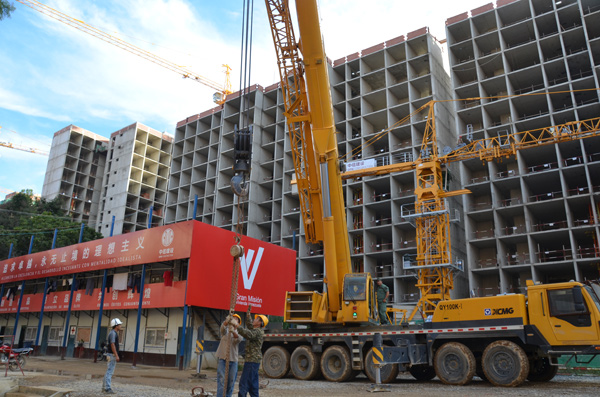 |
|
Chinese workers are seen at the construction site of a residential housing project undertaken by CITIC Construction Co Ltd in Venezuela. Xu Ye / Xinhua |
Latin American countries should annually invest 6.2 percent of their GDP (around $320 billion) on infrastructure development to meet their economic goals to 2020, the Economic Commission for Latin America and the Caribbean (ECLAC) said in its latest report.
That is the conclusion of a United Nations organization's study, which was prepared by the Infrastructure Services Unit of ECLAC's Natural Resources and Infrastructure Division.
The figure of 6.2 percent of gross domestic product comes from applying the investment trajectory to expected infrastructure needs, and it assumes that the historic pattern of country investments will be repeated. As such, it is an approximation and not a strict recommendation, the document indicates.
The average 2.7 percent of GDP allotted to infrastructure in the last decade has proved insufficient, the UN agency said, adding that quality of life cannot be improved without strong infrastructure.
"Investment in infrastructure projects increases [the] quality of public services (for example, health, education and recreation) and reduces the costs associated with mobility and logistics, which in turn improves access to markets of goods, services, employment and financing, providing a favorable environment for improvements in the population's overall well-being," the report stated.
The commission stressed that countries must examine the patterns in their investment decisions to orient them toward new infrastructures that reinforce the path to equality with sustainability and inclusion.
ECLAC unveiled the Economic Infrastructure Investment in Latin America and the Caribbean Database 1980-2012, which collects and systematizes figures by country and investment origin (public or private) and updates the annual investment requirements in four main economic infrastructure sectors (transportation, energy, telecommunications, and water and sanitation) to respond to the needs of the region's companies and end users in that same period.
Costa Rica led the ranking of infrastructure investment by using 5.4 percent of its GDP, followed by Uruguay (5.08%), Nicaragua (4.93%), Bolivia (4.47%), Peru (4.46%), Brazil (4.1%), Mexico (3.32%), Panama (3.32%) and Argentina.
Meanwhile, investing less than Argentina were Chile (2.83%), Colombia (2.45%), El Salvador (2.3%), Ecuador (1.58%), Guatemala (1.55%) and Paraguay (1.51%).
Chinese companies have shown increasing interest in Latin American infrastructure needs, especially in the energy sector.
A recent article published in Manzella Report says that Gezhouba, a Chinese construction and engineering company based in Wuhan won a $4.7 billion contract to build two new hydroelectric facilities in Santa Cruz, Argentina, with a combined capacity of 1.74 GW.
In Brazil, the Chinese State Grid is a key contractor for the 11.2 GW Belo Monte hydropower project. In Guyana, China Railway First Group was to build the 165 MW, $840 million Amaila Falls hydroelectric facility before the project ran into difficulties.
Ellis lists a host of other projects that include, for example, the $2.2 billion, 1.5 GW facility Coca Coda Sinclair (being built by the Chinese firm SinoHydro) in Ecuador.
After a Latin American visit by President Xi Jinping, a clutch of Chinese companies are looking to invest at least $450 million in Mexico in the initial phase of an infrastructure-led spending spree that the Mexican government has calculated to be worth $590 billion between 2014 and 2018.
Xinhua reported that Mexico is undergoing energy reform and opening energy investment to foreign investors. The plan for developing Mexican infrastructure during 2014 to 2018 calls for $600 billion in investment, among which $50 billion is in the power generating sector and $270 billion in the oil and gas industry.
Ding Yifan, deputy director at the Development Research Center of the State Council, also said in the meeting that the cooperation between China and Latin America in infrastructure has a bright outlook.
He suggested the RMB as a trade settlement and investment currency.
"Besides traditional infrastructure and energy investment, two parties should also thrive for sustainable development," he said. "Solar power and wind power are the two burgeoning industries in China; China can also bring the technologies to Latin America."
yangyao@chinadaily.com.cn
